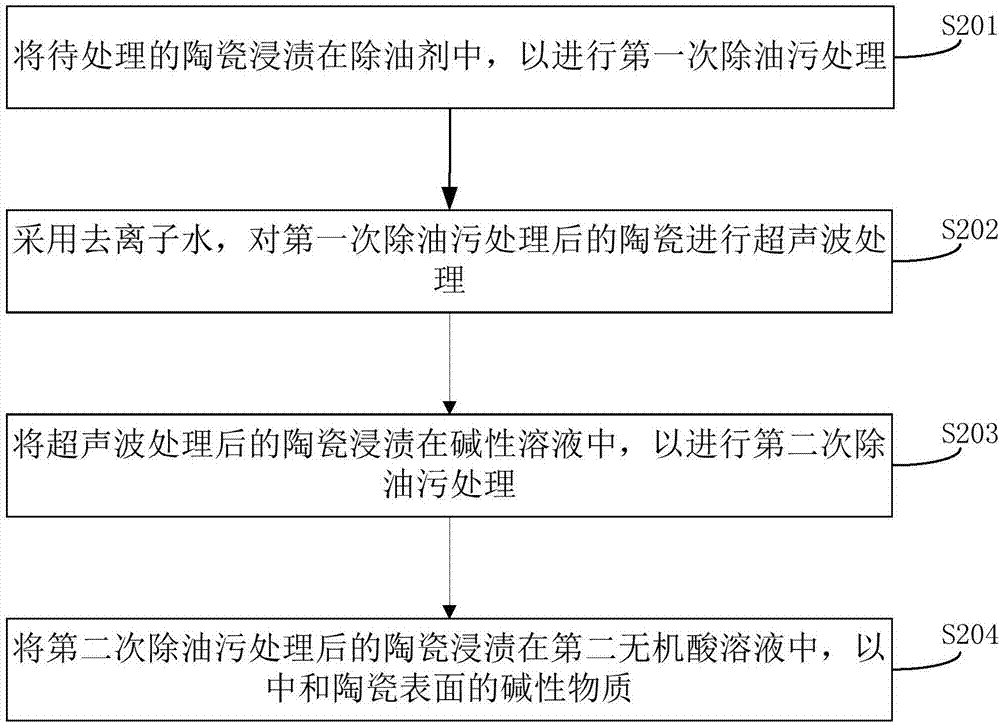Ceramic surface treatment method, ceramic product and ceramic plastic composite body
A technology of surface treatment and ceramic products, applied in the direction of coating, etc., can solve the problems of product structure independency, glue overflow and poor bonding, etc., and achieve the effect of strong bonding, tight bonding, and accelerated pitting corrosion
- Summary
- Abstract
- Description
- Claims
- Application Information
AI Technical Summary
Problems solved by technology
Method used
Image
Examples
Embodiment 1
[0048] Pretreatment: Immerse the ceramics in 30g / L Huiling 6007 for 600s. After taking them out, use deionized water to ultrasonically treat the degreasing agent on the surface of the ceramics, and then immerse them in 140g / L sodium hydroxide solution for the second Take it out after the first degreasing treatment for 300s, and then immerse it in 120g / L hydrochloric acid solution for neutralization treatment for 60s to complete the pretreatment;
[0049] The first surface etching: immerse the pretreated ceramics in the mixed solution of sodium fluoride and oxalic acid for 720s, wherein the concentration of sodium fluoride solution is 50g / L, and the concentration of oxalic acid solution is 20g / L;
[0050] The second surface etching: immerse the above-mentioned ceramics after the first surface etching in the mixed solution of nitric acid and copper sulfate for 420s, wherein the concentration of nitric acid is 200g / L, and the concentration of copper sulfate is 3g / L;
[0051] The ...
Embodiment 2
[0057] Pretreatment: Immerse the ceramics in 50g / L Huiling 6007 for 450s. After taking them out, use deionized water to ultrasonically treat the degreasing agent on the surface of the ceramics, and then immerse them in 180g / L sodium hydroxide solution for the second Take it out after the first degreasing treatment for 180s, and then neutralize it in 40g / L hydrochloric acid solution for 210s to complete the pretreatment;
[0058] The first surface etching: immerse the pretreated ceramics in the mixed solution of sodium fluoride and oxalic acid for 480s, wherein the concentration of sodium fluoride solution is 130g / L, and the concentration of oxalic acid solution is 40g / L;
[0059] The second surface etching: immerse the above-mentioned ceramics after the first surface etching in the mixed solution of nitric acid and copper sulfate for 540s, wherein the concentration of nitric acid is 100g / L, and the concentration of copper sulfate is 2g / L;
[0060] The first time to remove the ...
Embodiment 3
[0065] Pretreatment: Immerse the ceramics in 70g / L Huiling 6007 for 350s. After taking them out, use deionized water to ultrasonically treat the degreasing agent on the surface of the ceramics, and then immerse them in 100g / L sodium hydroxide solution for the second Take it out after the first degreasing treatment for 360s, and then neutralize it in 150g / L hydrochloric acid solution for 30s to complete the pretreatment;
[0066] The first surface etching: immerse the pretreated ceramics in the mixed solution of sodium fluoride and oxalic acid for 360s, wherein the concentration of sodium fluoride solution is 160g / L, and the concentration of oxalic acid solution is 50g / L;
[0067] The second surface etching: immerse the above-mentioned ceramics after the first surface etching in the mixed solution of nitric acid and copper sulfate for 240s, wherein the concentration of nitric acid is 300g / L, and the concentration of copper sulfate is 4g / L;
[0068] The first time to remove the ...
PUM
| Property | Measurement | Unit |
|---|---|---|
| concentration | aaaaa | aaaaa |
Abstract
Description
Claims
Application Information
 Login to View More
Login to View More - R&D
- Intellectual Property
- Life Sciences
- Materials
- Tech Scout
- Unparalleled Data Quality
- Higher Quality Content
- 60% Fewer Hallucinations
Browse by: Latest US Patents, China's latest patents, Technical Efficacy Thesaurus, Application Domain, Technology Topic, Popular Technical Reports.
© 2025 PatSnap. All rights reserved.Legal|Privacy policy|Modern Slavery Act Transparency Statement|Sitemap|About US| Contact US: help@patsnap.com



